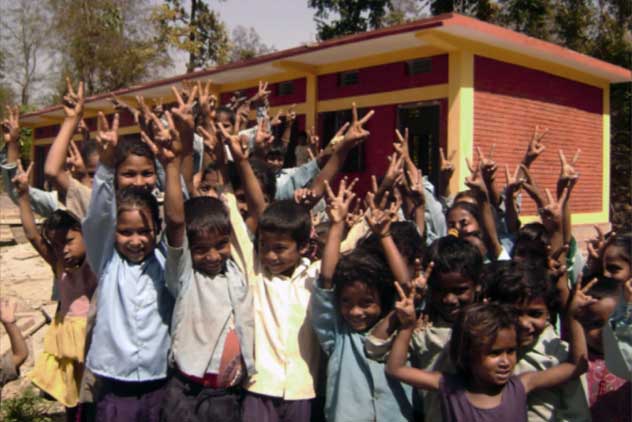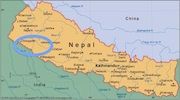The Primary School in Kaljugi, Nepal was completed on March 24, 2011!

The new Deep Jyoti Primary School
Kaljugi Community Profile
Kaljugi is a part of the Sadepani VDC (Village Development Committee) in the Kailali district of western Nepal. The village is located 64km northeast of Dhangadi, the district headquarters. The population of the village is 1284 people, living together in 217 households. Most of the houses in the village are made of wood and mud with tile roofs. 80% of the villagers are Dalits- outcasts known as untouchables in the centuries-old caste system of Nepal. Many of these people migrated over the last 40 years from hilly areas to Kaljugi, where the ground is more plane and they can be closer to the forest.
The primary activities of the people are agriculture and livestock breeding. Approximately 65% of people in Kaljugi go to India looking for work during non-harvesting time. This village is 4km north of Sukhad, a small market on the road. The climate is hot for a large part of the year- hottest from June to August- and cool from December to February.
The primary activities of the people are agriculture and livestock breeding. Approximately 65% of people in Kaljugi go to India looking for work during non-harvesting time. This village is 4km north of Sukhad, a small market on the road. The climate is hot for a large part of the year- hottest from June to August- and cool from December to February.
Prior School Conditions
Regarding basic infrastructure, there were no permanent classrooms in Kaljugi. The existing classrooms were made of mud and wood with tin roofing. The village has only a 9-year history of formal education, and the villagers have been unable to construct a safe and strong school building for their children due to their economic situation. They were eager and excited to work with buildOn to construct their first permanent school block. Prior to building the new school, there were 149 students (62 boys and 87 girls) enrolled in primary school. There are 2 government and 2 community teachers teaching grades 1-4.
Prior School Conditions
Deep Jyoti Primary School
The buildOn team in Nepal reports that this project finished ahead of schedule despite the fact that rice-harvesting season overlapped with the construction. The 12-member project leadership committee worked with buildOn staff to organize a careful rotation of community members on the worksite so that both the harvest and the school could be completed. This project also presented an extra challenge because of a wide river between the city and Kaljugi. Since there is no bridge close to the village, all the materials purchased by buildOn had to be transported on a long circuitous route so they could be driven over the river and delivered to the worksite.
The children of Kaljugi began using their new school on March 24th 2011. The new 3-classroom school block has a poured concrete floor and concrete slab roof. Inside, the classrooms are furnished with desks and seats and permanent chalkboards. Two latrines were also constructed next to the school.
The buildOn team in Nepal reports that this project finished ahead of schedule despite the fact that rice-harvesting season overlapped with the construction. The 12-member project leadership committee worked with buildOn staff to organize a careful rotation of community members on the worksite so that both the harvest and the school could be completed. This project also presented an extra challenge because of a wide river between the city and Kaljugi. Since there is no bridge close to the village, all the materials purchased by buildOn had to be transported on a long circuitous route so they could be driven over the river and delivered to the worksite.
The children of Kaljugi began using their new school on March 24th 2011. The new 3-classroom school block has a poured concrete floor and concrete slab roof. Inside, the classrooms are furnished with desks and seats and permanent chalkboards. Two latrines were also constructed next to the school.

Inside one of the three new classrooms
This school project broke ground on December 11th, 2010 and was completed on February 28th, 2011. During these 12 weeks of construction the people of Kaljugi contributed a total of 1, 143 volunteer workdays to the project and finished 10 days ahead of schedule. Before starting construction, they met with buildOn staff to sign a covenant outlining the following responsibilities:
Community Contribution
• Unskilled labor: 20 workers (10 women and 10 men) per day, six days per week
• Commitment to educating girls and boys equally
• The land on which the school will be built
• High quality local materials: sand, gravel, water & rocks
• Volunteer management committee made up of 12 villagers (six women, six men)
• Lodging for buildOn Field Coordinator and skilled laborers in local homes
• Basic construction tools (picks, buckets, etc.) when available
Opportunity For All & buildOn Contribution
• Engineering and architecture • Construction materials (excluding local materials) for school and latrine
• Skilled labor and plans needed to build the school
• Project management (buildOn coordinators)
• Instruction in basic construction techniques
• School furniture
Community Contribution
• Unskilled labor: 20 workers (10 women and 10 men) per day, six days per week
• Commitment to educating girls and boys equally
• The land on which the school will be built
• High quality local materials: sand, gravel, water & rocks
• Volunteer management committee made up of 12 villagers (six women, six men)
• Lodging for buildOn Field Coordinator and skilled laborers in local homes
• Basic construction tools (picks, buckets, etc.) when available
Opportunity For All & buildOn Contribution
• Engineering and architecture • Construction materials (excluding local materials) for school and latrine
• Skilled labor and plans needed to build the school
• Project management (buildOn coordinators)
• Instruction in basic construction techniques
• School furniture
“Education is important because it opens opportunities to a brighter future not only for the educated person, but also his family and the community he or she comes from. Educations means light, knowledge, self reliance and development.”
- Siaka Traore, chief of Nienabale, 56 years old
“I will help build this school because it is the best gift we kids have ever had and I would like to attend class in this school. It will give us the chance to go to school in our own village, close to our parents.”
- Bambino Traore, student, 10 years old
- Siaka Traore, chief of Nienabale, 56 years old
“I will help build this school because it is the best gift we kids have ever had and I would like to attend class in this school. It will give us the chance to go to school in our own village, close to our parents.”
- Bambino Traore, student, 10 years old

The teachers

Students in front of the school
